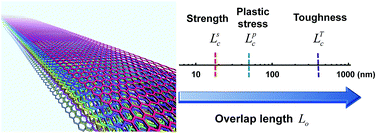Critical length scales and strain localization govern the mechanical performance of multi-layer graphene assemblies†
Abstract
Multi-layer graphene assemblies (MLGs) or fibers with a staggered architecture exhibit high toughness and failure strain that surpass those of the constituent single sheets. However, how the architectural parameters such as the sheet overlap length affect these mechanical properties remains unknown due in part to the limitations of mechanical continuum models. By exploring the mechanics of MLG assemblies under tensile deformation using our established coarse-grained molecular modeling framework, we have identified three different critical interlayer overlap lengths controlling the strength, plastic stress, and toughness of MLGs, respectively. The shortest critical length scale Lsc governs the strength of the assembly as predicted by the shear-lag model. The intermediate critical length Lpc is associated with a dynamic frictional process that governs the strain localization propensity of the assembly, and hence the failure strain. The largest critical length scale LTc corresponds to the overlap length necessary to achieve 90% of the maximum theoretical toughness of the material. Our analyses provide the general guidelines for tuning the constitutive properties and toughness of multilayer 2D nanomaterials using elasticity, interlayer adhesion energy and geometry as molecular design parameters.


 Please wait while we load your content...
Please wait while we load your content...